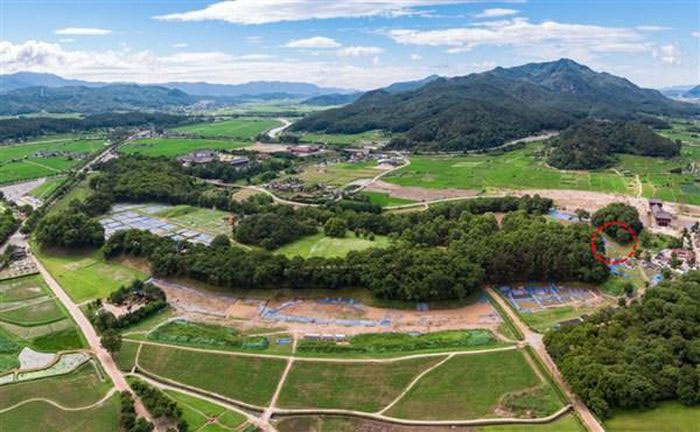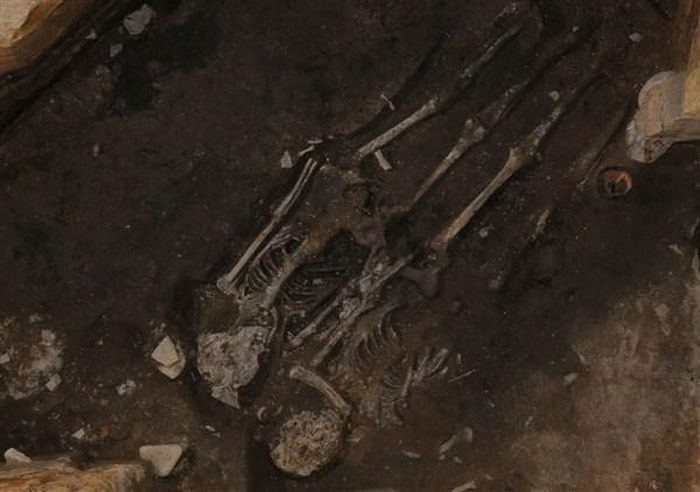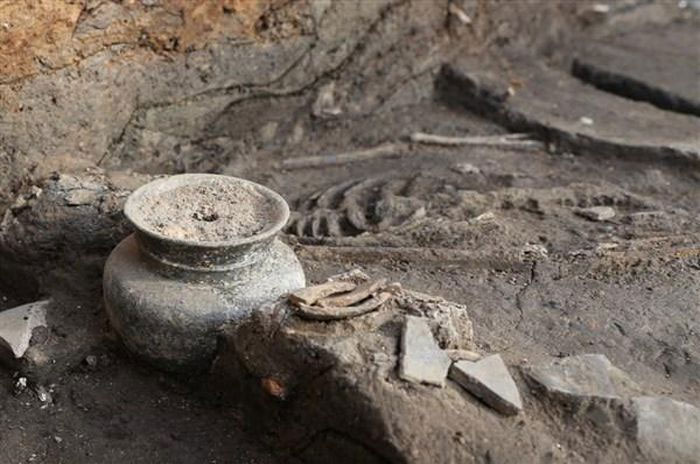Since 2017, South Korean archaeologists have discovered three skeletons at the base of the walls of Wolseong Palace, the remnants of the Gyeongju capital of Silla (57 BC – 935 AD).
Upon verification, they confirmed that these were ancient residents who had been sacrificed for ritual purposes.
The First Dynasty
According to records from the Samguk Sagi – the oldest historical document in Korea, Silla was established in 57 BC. However, “it did not resemble a kingdom until the 4th century,” said Mark Byington, President of the Korea Institute (USA).

Historical site of Gyeongju and the location of the three sacrificial victims (circled).
In the years before Christ, Silla was likely just a dominant force among various groups coexisting on the Korean Peninsula. With a strong military, they suppressed their rivals and emerged as the leaders.
After successfully unifying their territory, Silla began to establish a dynasty and designated Gyeongju as its capital. Here, they constructed the first palace and city walls – Gyeongju Capital.
Around 50 – 70 AD, Silla began the construction of Wolseong Palace. It is likely that this period marked the true beginning of the Silla Kingdom.
Wolseong is situated on a hill and has an overall structure resembling a crescent moon, hence it is also referred to as the Moon Palace. During the construction of Wolseong, Silla faced two major enemies: Baekje to the southwest and Goguryeo to the north. They formed a tripod structure, leading to the Three Kingdoms Period.
The Sacrificial Skeletons

Skeletons of a couple of farmers in their 50s at the base of the Moon Palace walls.
In the 1980s, a pioneering group of South Korean archaeologists excavated the site of the Moon Palace. They found human and animal bones. There were no records in Silla’s history about the practice of sacrificing living beings to build city walls, so no researchers anticipated such an occurrence during the construction of Wolseong.
In 2017, another archaeological team chose a section of the Moon Palace wall approximately 36 meters long and over 9 meters high to excavate. They uncovered two skeletons, one male and one female, lying side by side at the base of the wall.
Analysis of the two skeletons revealed that they were a couple of farmers in their 50s. There were no signs of struggle or injuries prior to death, raising suspicions of death by sacrifice.
Although Korean history does not record any human sacrifices during construction, many chilling stories have been passed down through folklore. According to these tales, since the Silla era, rulers had sacrificed living people to protect fortifications, and even tombs.
The individuals chosen for sacrifice were typically from the lowest social classes. According to Samguk Sagi, the Silla elite routinely buried slaves alive in tombs to serve as guardians for the coffins. The situation became so serious that in 502 AD, the reigning king had to issue a prohibition.
In early 2021, South Korea made another shocking discovery at the Moon Palace. This was the skeleton of a young girl, buried just a few steps away from the couple of elderly farmers.
The girl still had a bracelet on her wrist and an earring on her head, both made of glass. These were inexpensive jewelry items favored by the impoverished people of ancient Silla.
Human Sacrifice in Wall Construction

Skeleton of the young girl, just a few steps away from the elderly farmer couple.
The skeleton of the young girl at the base of the Moon Palace walls supports the theory of human sacrifice during wall construction. Upon overall observation, South Korean archaeologists noted the special design of the wall’s foundation structure.
It was designed to have specific spaces reserved for the skeletons. It is predicted that the three sacrificial victims were killed simultaneously and placed within the foundation of the wall, with the intention of praying for its durability.
Within the foundation where the couple of farmers were buried, there were several pieces of broken pottery. In the foundation where the young girl was buried, there was an intact pottery jar and a small bowl. Analysis of the bones and teeth of all three victims showed signs of nutritional deficiency.
“We believe they were merely individuals from the lowest social class,” archaeologist Jang Ki-myeong from the Gyeongju National Institute speculated. After burying these three victims in the foundation, the Silla builders proceeded to construct the wall.
Returning to the time of the commencement of the Moon Palace, Silla was constantly threatened by Baekje and Goguryeo. This was a perilous period for the newly formed nation. At any moment, they could be attacked and devastated by enemies.
In their role as rulers, the Silla kings may have disregarded ethics, doing everything necessary to protect the palace. They mimicked the superstitious practice of sacrificing wall builders from China, killing some of their subjects and burying them within the wall’s foundation.
In 2000, the entire historical site of Gyeongju, South Korea, was recognized by UNESCO as a World Heritage Site. In addition to the Moon Palace, there are approximately 7,000 temples, shrines, tombs, and other ancient architectural structures. It preserves the history and artifacts of over 1,000 years of the Silla Dynasty.


















































